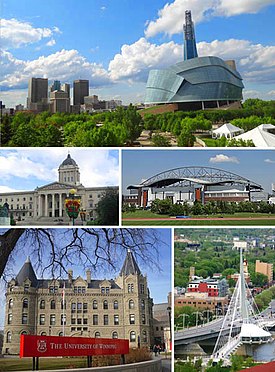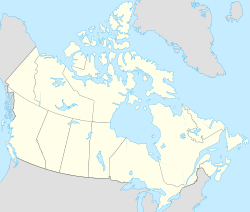Winnipeg
Winnipeg (pronounced /ˈwɪnɨpɛg/) is the largest city of Manitoba, Canada. It is in the eastern prairie region of western Canada. It is often called the "Gateway to the West".[13][14] Winnipeg is the seventh biggest city in Canada with a population of 705,244 people.[15]
Winnipeg | |
|---|---|
City | |
| City of Winnipeg Ville de Winnipeg | |
 Clockwise from top: Downtown featuring the Canadian Museum for Human Rights, Investors Group Field, Saint Boniface and the Esplanade Riel bridge, Wesley Hall at the University of Winnipeg, Manitoba Legislative Building. | |
| Nicknames: | |
| Motto(s): | |
| Coordinates: 49°53′58″N 97°08′21″W / 49.89944°N 97.13917°W | |
| Country | Canada |
| Province | Manitoba |
| Region | Winnipeg Capital |
| Established | 1738 (Fort Rouge) |
| Renamed | 1822 (Fort Garry) |
| Incorporated | 1873 (City of Winnipeg) |
| Government | |
| • Mayor | Scott Gillingham |
| • Governing body | Winnipeg City Council |
| • MPs | List of MPs |
| • MLAs | List of MLAs |
| Area | |
| • Land | 464.08 km2 (179.18 sq mi) |
| • Metro | 5,306.79 km2 (2,048.96 sq mi) |
| Elevation | 239 m (784 ft) |
| Population | |
| • City | 705,244 (7th) |
| • Density | 1,430/km2 (3,700/sq mi) |
| • Urban | 705,244 (7th) |
| • Urban density | 1,429/km2 (3,700/sq mi) |
| • Metro | 778,489 (8th) |
| • Metro density | 146.70/km2 (380.0/sq mi) |
| Demonym | Winnipegger |
| Time zone | UTC−6 (CST) |
| • Summer (DST) | UTC−5 (CDT[12]) |
| Forward sortation area | |
| Area code(s) | 204 and 431 |
| Website | www |
The name "Winnipeg" comes from the Cree word for "muddy waters." Winnipeg is at the place where the Red River and Assiniboine river join. That area is known as The Forks.
Winnipeg has four professional sports teams. The teams are the "Winnipeg Blue Bombers" who play football, the "Winnipeg Jets" who play hockey, the Winnipeg Goldeyes who play baseball and the Winnipeg Alliance FC who play soccer. Winnipeg has four universities: the University of Manitoba, the University of Winnipeg, Canadian Mennonite University and University of St. Boniface.
Winnipeg is in a very flat part of Canada. Winnipeg has four rivers in it. These rivers are the Red River, the Assiniboine River, the La Salle River, and the Seine River. Winnipeg has floods in spring a lot because it is in a very flat area that gets a lot of snow and rain. In winter, Winnipeg is cold and gets a lot of snow. The hottest day in Winnipeg was in the year 1936, when it was 42 degrees Celsius. The coldest day in Winnipeg was in the year 1879, when it was -47 degrees Celsius.
History
changeThe area that we now call Winnipeg was used by First Nations people for many thousands of years before people from Europe arrived. First Nations people used this area a lot. This area was important because it is where two rivers meet. First Nations peoples often moved around using the rivers on canoes (a small boat that is powered by people with paddles).
The first person from Europe to come to this area was an officer from France in the year 1738. This area was first used as a permanent settlement (place where people live) by European people in the year 1812. Winnipeg was incorporated (officially made into a city) in the year 1873. Winnipeg became big because trains brought money and people from other places along the railroads. After World War I, Winnipeg stopped getting bigger for a long time. After World War II, Winnipeg has been getting bigger again. In the year 1972, Winnipeg got bigger by adding other small cities nearby into one big city, and the new big city was also named Winnipeg.[16]
Cityscape and Politics
changeWinnipeg has a downtown area in the middle of the city. The downtown area has many tall buildings. Downtown is a place where there are a lot of offices and stores. All around Winnipeg's downtown are residential neighbourhoods (places where people live).
There is a big road that goes all the way around the city. This road is called the Perimeter Highway. The two best known roads in Winnipeg are called Portage Avenue and Main Street. The place where these two roads meet is in the middle of Winnipeg's downtown area. Main Street goes from the middle of the city to the northern part of the city. Portage Avenue goes from the middle of the city to the western part of the city.
The mayor of Winnipeg makes decisions about the city in City Hall. Winnipeg's mayor is a man named Brian Bowman. City Hall is in downtown Winnipeg.
The provincial premier is a person who makes decisions about Manitoba. Manitoba is the province that Winnipeg is in. Manitoba's provincial premier is Brian Pallister. The premier makes decisions at the legislative building.
-
The Red River
-
Downtown Winnipeg
-
Osborne Village, a part of Winnipeg where people live
-
Winnipeg's "Legislative Building", where Manitoba politics happen
-
Winnipeg in winter
Television
change| OTA virtual channel (PSIP) |
OTA channel | Shaw Cable | Call Sign | Network | Notes |
|---|---|---|---|---|---|
| 6.1 | 27 (UHF) | 2 | CBWT-DT | CBC Television | |
| 9.1 | 40 (UHF) | 12 | CKND-DT | Global | |
| 13.1 | 13 (very high frequency) | 8 | CHMI-DT | Citytv |
References
change- ↑ Goodhand, Margo (10 October 2012). "Winnipeg Now was 100 years in the making". Winnipeg Free Press.
- ↑ Williams, Rob (31 December 2011). "Live ... in the Peg!". Winnipeg Free Press.
- ↑ Kives, Bartley (2 December 2012). "Proud to be Winterpeg". Winnipeg Free Press.
- ↑ Municipal Manual. City of Winnipeg. 2007. p. 16.
- ↑ "Census subdivision of Winnipeg". Statistics Canada. 8 February 2012. Retrieved 3 March 2014.
- ↑ "Census metropolitan area of Winnipeg". Statistics Canada. 8 February 2012. Retrieved 3 March 2014.
- ↑ "Census Profile, 2016 Census Winnipeg Census metropolitan area". Statistics Canada. 8 February 2017. Retrieved 8 February 2017.
- ↑ "Census Profile, 2016 Census Winnipeg, City". Statistics Canada. 8 February 2017. Retrieved 8 February 2017.
- ↑ "Population and dwelling counts, for Manitoba and census subdivisions". Statistics Canada. 8 February 2012. Retrieved 6 April 2012.
- ↑ "Metropolitan areas of Manitoba". Statistics Canada. Retrieved 8 February 2011.
- ↑ "Population counts, for census metropolitan areas, census agglomerations, population centres and rural areas, 2011 Census". Statistics Canada. 11 April 2012. Retrieved 10 August 2012.
- ↑ "Winnipeg". The World Clock. Retrieved 3 March 2014.
- ↑ Imperial Oil website. "Winnipeg History". Archived from the original on 2007-01-27. Retrieved 2008-06-15.
- ↑ City of Winnipeg website. "Winnipeg History". Retrieved 2008-06-15.[permanent dead link]
- ↑ "Population and dwelling counts, for census metropolitan areas, 2011 and 2006 censuses". Retrieved 12 November 2012.
- ↑ "Winnipeg's History". City of Winnipeg. Archived from the original on 19 August 2011. Retrieved 12 November 2012.
Other websites
change| Definitions from Wiktionary | |
| Media from Commons | |
| News stories from Wikinews | |
| Quotations from Wikiquote | |
| Source texts from Wikisource | |
| Textbooks from Wikibooks | |
| Learning resources from Wikiversity | |
- Winnipeg.ca - Official Winnipeg website



